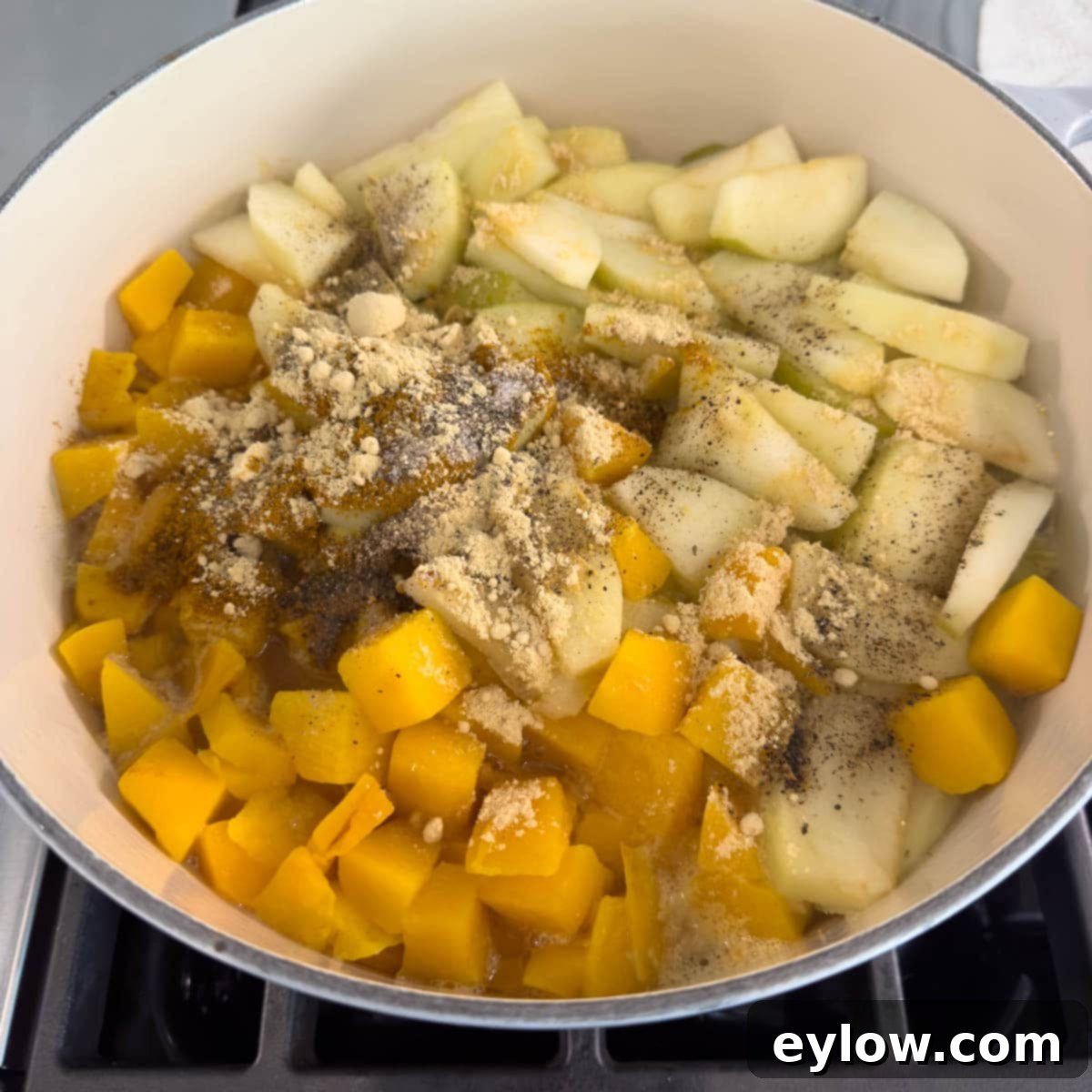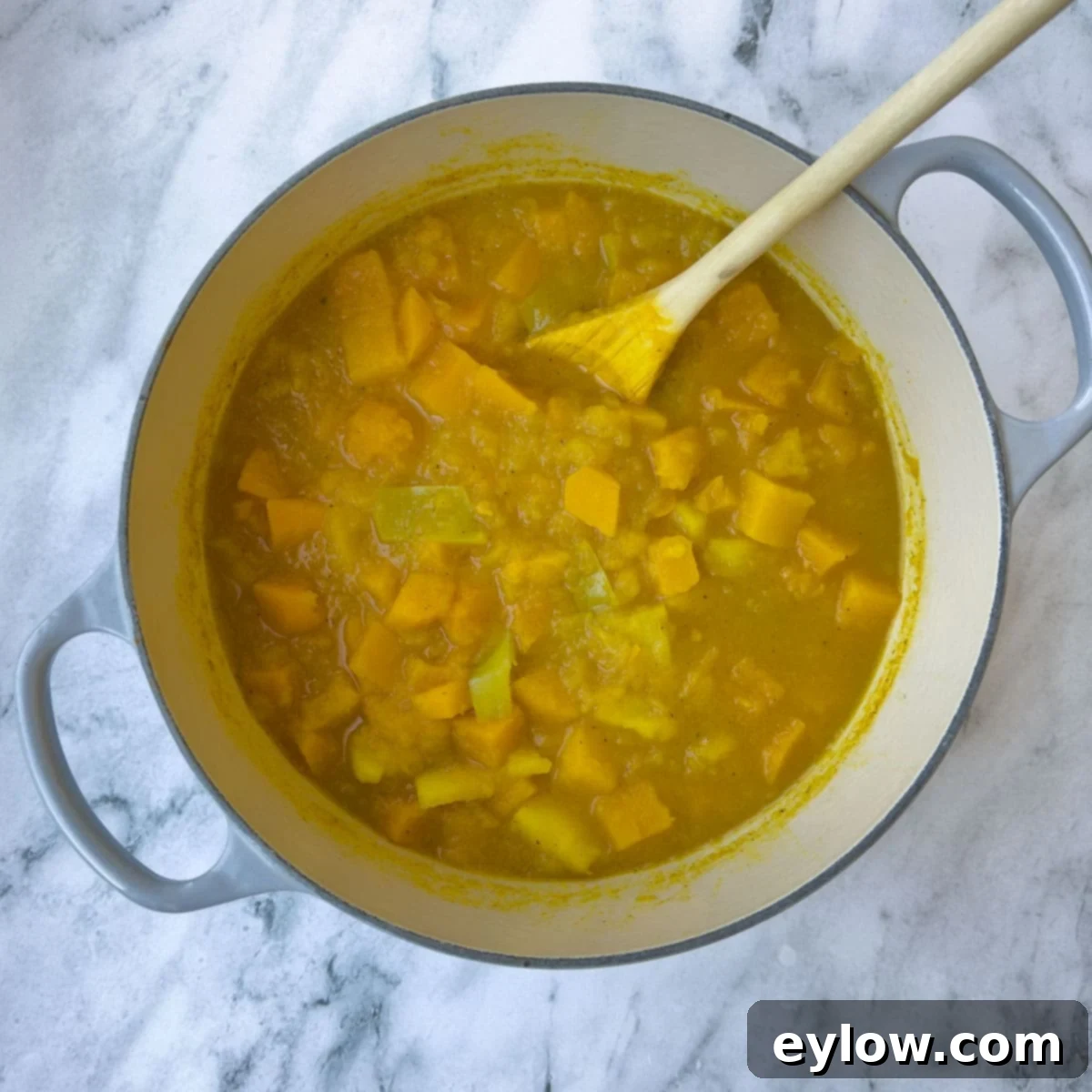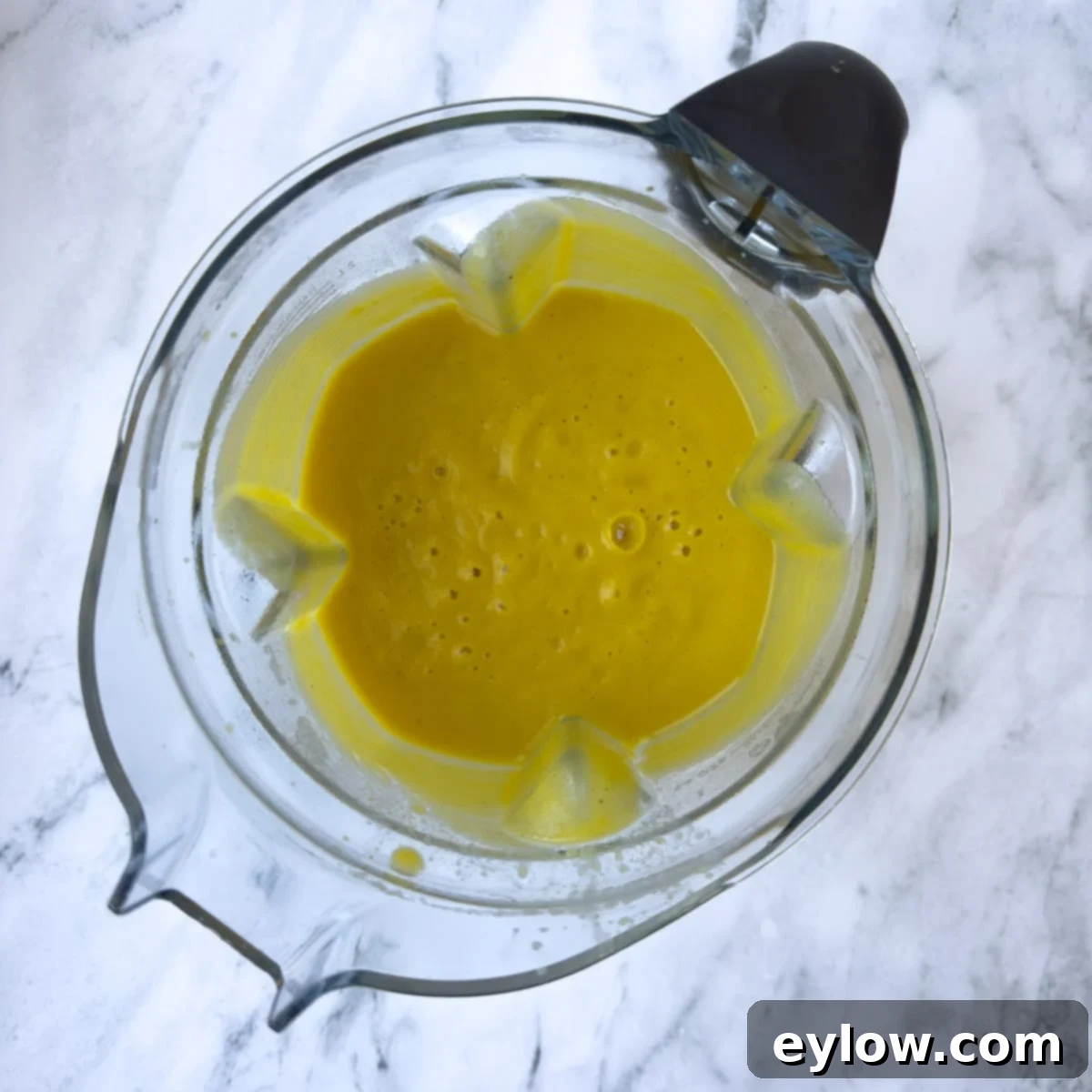Velvety Butternut Squash and Apple Soup: A Creamy, Dairy-Free Fall Delight
Embrace the vibrant flavors of autumn with this incredibly smooth and beautifully golden butternut squash and apple soup. This recipe transforms humble fall produce into a sophisticated yet comforting dish that’s surprisingly simple to prepare. The secret to its luscious, velvety texture lies in rich coconut milk, which also makes it naturally dairy-free and vegan-friendly. Infused with warming curry powder and a hint of ginger, the soup boasts a gorgeous, inviting color that’s as appealing to the eye as it is to the palate. Just a quick simmer of squash and apples until tender, a gentle stir of aromatic spices and coconut milk (or your preferred creamy alternative), followed by a swift puree, and you’ll achieve a silky-smooth consistency that truly melts in your mouth. This comforting soup serves as the perfect culinary bridge between the seasons, offering warmth and nourishment as the days grow cooler.

Some might wonder, “Apples in soup?” And to that, we say: absolutely! This elegant, creamy soup beautifully marries the earthy sweetness of butternut squash with the crisp, tart notes of Granny Smith apples. The addition of aromatic curry powder and spicy ginger creates a comforting depth of flavor that is truly irresistible. Whether you follow a gluten-free or dairy-free diet, or simply enjoy wholesome, flavorful food, this butternut apple soup is an exceptional addition to your collection of cherished homemade recipes. It’s a versatile dish that caters to various dietary needs without compromising on taste or texture, making it a crowd-pleaser for any occasion. The balance of sweet and savory, combined with the creamy richness, makes this soup an instant fall favorite that you’ll want to make year after year.
Why You’ll Adore This Butternut and Apple Soup
- Simple Ingredients, Effortless Method – This recipe shines in its simplicity. You’ll only need a handful of readily available pantry items and fresh produce staples. These ingredients are simmered together until tender, then blended into a luxurious, silky-smooth soup. The minimal preparation time and straightforward steps make it an ideal choice for busy weeknights or a relaxing weekend cooking project.
- Perfect for Meal Prep & Entertaining – Prepare a large batch of this delightful soup, and you’ll have delicious, wholesome meals ready for days. It stores exceptionally well in the refrigerator for up to 4-5 days, making it perfect for efficient meal prepping. Its elegant presentation and rich flavor also make it a fantastic choice for entertaining guests, whether as a sophisticated appetizer or a comforting main course.
- Naturally Hearty and Wholesome – Don’t let its vegan and dairy-free nature fool you; this soup is incredibly rich, filling, and deeply satisfying. The natural starches of the butternut squash and apples, combined with the creaminess of coconut milk, create a hearty texture that will leave you feeling nourished. While it’s wonderful as is, you always have the option to incorporate dairy products if that’s your preference.
Essential Recipe Ingredients for Butternut Apple Soup

- Butternut Squash: This star ingredient brings natural sweetness and a beautiful orange hue to the soup. You can opt for a whole butternut squash, which offers the freshest flavor and allows you to use the seeds for roasting. Alternatively, to save time and effort on peeling and chopping, pre-cubed and bagged butternut squash is a convenient choice. When selecting a whole squash, look for one that is firm, heavy for its size, and has a dull, matte finish, indicating ripeness.
- Apples: The secret to balancing the squash’s sweetness is using tart apples. Granny Smith apples are my top recommendation for their vibrant acidity and firm texture, which holds up well during cooking. If you prefer a slightly sweeter soup, crisp-sweet varieties like Honeycrisp, Braeburn, Jazz, or Pink Lady apples work beautifully. These varieties offer a pleasant sweetness without making the soup overly sugary. For more details on choosing the perfect apple for your culinary needs, explore various apple varieties on this informative website. Remember not to peel the apples, as their skins contain valuable nutrients and soften completely during simmering, adding to the soup’s texture and color.
- Coconut Milk: For a truly rich and creamy soup without any dairy, canned full-fat coconut milk is indispensable. Be sure to choose canned varieties, as opposed to the thinner, boxed, or diluted brands, to achieve the desired luscious consistency. The fat content in canned coconut milk is crucial for the soup’s luxurious mouthfeel.
- Spices: The warming flavors of curry powder and ginger are what elevate this soup beyond a simple vegetable puree. Curry powder provides an intricate blend of savory and aromatic notes, while ginger adds a zesty, slightly pungent kick. For ginger, you have options: dry ground ginger offers a convenient solution, or for a fresher, more intense flavor, use finely minced or pureed ginger from a jar or tube. These spices beautifully complement the sweetness of the squash and apples, creating a harmonious and comforting flavor profile. A pinch of ground clove or nutmeg can also be added for an extra layer of warmth, especially during the colder months.
For precise quantities and detailed measurements of all ingredients, please refer to the comprehensive recipe card located at the end of this post. It contains all the essential information to ensure your soup turns out perfectly.
Chef’s Note: A Unique Soup Experience. This butternut apple soup distinguishes itself from typical soup recipes that rely heavily on aromatics like onions, carrots, and celery, or on a foundational chicken or vegetable broth. Its remarkable depth of flavor and creamy texture are derived almost entirely from the natural sweetness and starchiness of the squash and apples, harmoniously blended with the exotic warmth of spices and the rich creaminess of coconut milk. After a quick simmer, a simple puree transforms these wholesome ingredients into a luxurious and satisfying dish. You’ll be astonished by how such a straightforward process yields such an incredibly delicious and complex soup.
Versatile Substitutions and Creative Variations
This butternut apple soup recipe is wonderfully adaptable, allowing you to easily customize it to suit your dietary needs, personal preferences, or whatever ingredients you have on hand. Here are some ideas to inspire your culinary creativity:
- If you cannot or prefer not to use coconut milk, there are several excellent alternatives to achieve a similar creamy consistency. For a plant-based option, consider a thick cashew cream, almond cooking cream, or even a potato-based dairy-free creamer. If you don’t require the soup to be dairy-free, full-fat heavy cream or half-and-half can be used to impart a rich, luxurious texture and flavor. Adjust the amount to your desired creaminess.
- For those who appreciate a soup with a bit of a kick, easily transform this into a spicy butternut squash soup. Incorporate a pinch of chipotle powder for a smoky heat, or a dash of cayenne pepper for a more direct spice. If you prefer to control the heat level at the table, simply serve the soup with a sprinkle of red pepper flakes or a drizzle of your favorite hot sauce. Sriracha or a smoky chili oil can add a fantastic dimension.
- To add protein and make this soup a more substantial meal, consider browning some savory chicken and apple sausage, slicing it, and adding it as a garnish on top of each serving. The subtle sweetness of the sausage pairs wonderfully with the soup’s flavors. Alternatively, crispy crumbled bacon offers a delightful salty counterpoint to the inherent savory sweetness of the soup. For a vegetarian protein boost, roasted chickpeas or a swirl of red lentils cooked into the soup can also be excellent additions.
- Looking for other warm spice options? A small pinch of ground clove or nutmeg (or both) can add an extra layer of autumnal warmth and complexity to the soup’s aromatic profile. A touch of allspice or even a whisper of cardamom could also be explored for a truly unique flavor.
- If you prefer your soup a little more on the sweet side, a gentle drizzle of maple syrup over each serving before serving can enhance its natural sweetness. For a no-added-sugar option that still provides that touch of sweetness, consider using a monk fruit-based maple syrup, which is what I personally use and highly recommend. A tiny bit of brown sugar or agave nectar could also work.
Step-by-Step Guide: Crafting Your Butternut Apple Soup
Creating this velvety butternut apple soup is a straightforward process, but proper preparation of your main ingredients is key. If you’re working with a whole butternut squash, you’ll want to start by carefully peeling, seeding, and chopping it into manageable pieces. For a detailed visual guide on how to safely and efficiently prepare a whole butternut squash, refer to the dedicated section at the end of this post. Next, core and chop your apples. It’s important to remember that you do not need to peel the apples; their skins are packed with beneficial nutrition and will soften beautifully during the cooking process, contributing to the soup’s overall texture and flavor. Always ensure you use a good produce wash to clean your fruits and vegetables thoroughly before preparation.




Chef’s Tip: Safely Blending Hot Liquids. When pureeing soup or any other hot liquids in a standard upright blender, it is crucial to exercise caution. To prevent steam buildup and potential lid explosions, place a folded kitchen towel securely over the blender lid, holding it firmly in place with one hand. Start the blender on the lowest speed setting and gradually increase it, allowing steam to escape while pureeing the soup until it’s perfectly smooth. Remember, the blender carafe should never be more than half full when blending hot liquids, as they expand quickly when agitated. If you are using an immersion blender, position the pot in the sink to contain any potential splatters and begin blending slowly. Wearing an apron is highly recommended to protect your clothing!
Mastering the Art of Cutting Butternut Squash
Cutting a whole butternut squash can seem daunting due to its tough skin, but with the right technique and a sharp knife, it becomes a much easier and safer task. Here’s a detailed, step-by-step guide to help you prepare your squash:
- Trim and Separate with Precision – Begin by placing the squash on a stable cutting board. Using a sharp chef’s knife, carefully slice off about a quarter-inch from both ends of the squash. This creates flat, stable surfaces. Next, cut the squash into two distinct sections: one at the neck (the long, cylindrical part) and the other at the bulbous base. Separating these two parts makes handling and peeling much more manageable.
- Peel with Ease – Now that you have two more manageable pieces, it’s time to remove the tough outer skin. A Y-shaped vegetable peeler is typically the most effective tool for this job, as it conforms well to the contours of the squash. Apply firm, steady pressure, peeling away from your body to remove the skin in strips until all the bright orange flesh is exposed.
- Scoop Out the Seeds – Take the bulbous section of the squash and cut it in half lengthwise. You will see the seeds and fibrous strands clustered inside. Use a sturdy spoon, such as a metal tablespoon or an ice cream scoop, to easily scoop out and discard these seeds and stringy bits.
- Cube to Your Desired Size – For consistent cooking and easy blending, aim for uniformly sized cubes. Lay each peeled and seeded piece of squash flat on your cutting board. First, cut it into thick slices, then turn the slices and cut them into strips. Finally, dice these strips into cubes of your desired size, typically about 1-inch pieces for soup. Always ensure your knife is sharp and you use a stable surface to prevent accidents.
👉For more comprehensive, step-by-step photos that clearly illustrate how to peel and prep squash quickly and safely, you can refer to my detailed post on easy roasted butternut squash. This visual guide will further enhance your confidence in handling this versatile vegetable.
Delightful Serving Suggestions
This creamy butternut apple soup is incredibly versatile and can be enjoyed in various ways, fitting seamlessly into any meal plan or occasion:
For Appetizers: Elevate your entertaining by serving this elegant soup as a charming appetizer. Pour small portions into espresso cups or mini mugs. It makes a sophisticated and warming starter for a Thanksgiving feast, holiday gathering, or even a cozy game day with friends. Garnish with a tiny sprig of fresh herb or a single toasted pumpkin seed for a refined touch.
For a Hearty Lunch: This soup transforms into a satisfying lunch when paired with complementary sides. Serve it alongside classic grilled cheese sandwiches, offering a comforting dip, or with a savory turkey sandwich for a balanced meal. A fresh, crusty baguette for dipping is also a wonderful choice.
As a Main Dish: To make this soup the star of your dinner table, serve generous bowls accompanied by a crisp, refreshing green salad. A simple vinaigrette will cut through the soup’s richness beautifully. Add some warm garlic toast or a freshly baked crusty roll for dipping and a truly complete and comforting meal. For an extra layer of flavor and protein, consider adding browned chicken and apple sausage slices or crispy crumbled bacon as a topping.
For Garnishes: Enhance both the visual appeal and flavor of your soup with thoughtful garnishes. Toasted pumpkin seeds (pepitas) add a delightful crunch and nutty flavor. Fresh herbs such as finely chopped chives, thinly sliced green onions, fresh parsley, or delicate sage leaves bring brightness and a pop of color. For a creamy and tart contrast, a dollop of plain Greek yogurt or sour cream (or a dairy-free alternative) swirled on top offers a wonderful balance to the soup’s savory sweetness. A sprinkle of freshly ground black pepper or a swirl of good quality olive oil can also add a final touch of sophistication.
Storage & Freezing Tips for Butternut Apple Soup
This butternut and apple soup is an excellent make-ahead option, simplifying meal prep for busy weeks. When stored properly in an airtight container, it will maintain its delicious flavor and quality for up to 5 days in the refrigerator. This makes it perfect for having healthy, comforting meals on hand throughout the week.
Freezing is also a viable option for longer-term storage, though the results can vary slightly depending on the type of creaminess agent used:
- With Coconut Milk: Soups made with coconut milk may sometimes turn slightly grainy or separate a bit after being frozen and then thawed. This is a common occurrence due to the fat content in coconut milk. To remedy this, simply re-blend the soup vigorously using an immersion blender or by carefully transferring it back to a standard blender after thawing. This will restore its smooth, velvety consistency.
- With Cream or Half-and-Half: If you used dairy cream or half-and-half, the soup generally tends to freeze better with less textural change. However, some slight separation can still occur upon thawing. A good stir while reheating, or a quick whisk, should bring it back to its original creaminess.
For optimal flavor and texture, aim to enjoy your frozen butternut apple soup within 2 months. Always label and date your containers before freezing to keep track of freshness. When reheating frozen soup, it’s best to thaw it overnight in the refrigerator first, then gently heat it on the stovetop over low heat, stirring occasionally until warmed through.

Butternut Apple Soup: Your Questions Answered
While Granny Smith apples are highly recommended for their bright tartness, which perfectly balances the natural sweetness of butternut squash, you absolutely have the flexibility to use different apple varieties in this soup. The key is to consider the overall flavor profile you desire. If you prefer a more pronounced tartness, stick with Granny Smith or a similar tart apple. For a sweeter soup, opt for crisp-sweet apples like Honeycrisp, Braeburn, Jazz, or Pink Lady. These varieties will contribute a lovely sweetness and still hold their shape well during cooking. Always think about how the apple’s flavor will interact with the spices and squash to achieve a harmonious and delicious result.
Adjusting the thickness of your butternut apple soup is quite simple, and it’s always easier to thin soup than to thicken it. Start by aiming for a relatively thick consistency after pureeing. If you find the soup is too thick for your preference, gradually add small amounts of additional liquid while stirring until you reach your desired consistency. You can use extra coconut milk, dairy cream/half-and-half (if not keeping it dairy-free), vegetable broth, or even a little water. Add the liquid slowly, a tablespoon at a time, until it’s just right. If, however, your soup is too thin, you can return it to the pot and gently simmer it, uncovered, for a bit longer to allow some of the liquid to evaporate, thereby thickening the soup. Another option is to mix a teaspoon of cornstarch with a tablespoon of cold water, then stir this slurry into the simmering soup and cook for a few more minutes until thickened.
Yes, butternut apple soup freezes beautifully, making it an excellent choice for meal planning and enjoying later. You have two main options: you can make the soup entirely ahead of time and store it in the refrigerator for 3-4 days, or you can cool it down and freeze it for up to 3 months. To freeze, ensure the soup is completely cooled after cooking. Then, transfer it to airtight, freezer-safe containers or heavy-duty freezer bags, leaving a little headspace for expansion. Label and date your containers clearly. For optimal food safety, always chill cooked soup to 70°F (21°C) or below within two hours before refrigerating or freezing. When you’re ready to enjoy, thaw the frozen soup overnight in the refrigerator. Once thawed, transfer it to a medium pot and reheat gently over low heat, stirring occasionally until it is thoroughly warmed through. If the soup appears a bit separated or grainy after thawing (especially with coconut milk), a quick re-blend with an immersion blender or standard blender will restore its smooth texture.
Absolutely! Roasting the butternut squash before adding it to the soup will add a wonderful depth of flavor and a slightly nutty caramelization that simmering alone won’t provide. To do this, peel, seed, and cube the squash as directed. Toss it with a drizzle of olive oil, salt, and pepper, then roast in a preheated oven at 400°F (200°C) for 20-30 minutes, or until tender and lightly browned. You can even roast the apples alongside the squash for an enhanced flavor. Once roasted, proceed with the recipe, reducing the initial simmering time as the squash will already be tender. This step adds an extra layer of complexity to the soup’s taste profile.
For this butternut apple soup, a mild or medium curry powder is generally recommended to achieve a balanced and warming flavor without overpowering the natural sweetness of the squash and apples. A “Madras” style curry powder often works well, offering a good blend of aromatic spices. However, feel free to use your preferred blend. If you like a stronger curry flavor, you can increase the amount slightly, or if you prefer a very subtle hint, use a bit less. Always taste and adjust seasonings to your personal preference. The goal is to complement, not mask, the inherent flavors of the main ingredients.
Explore More Delicious Fall Recipes with Squash
If you loved this butternut apple soup and are eager to discover more comforting and flavorful dishes, especially during the fall season, you’re in luck! We have a wide array of recipes to satisfy your cravings. Be sure to check out our dedicated soups recipe page for a diverse collection of warming bowls, from hearty stews to light broths. And for those following a vegan diet or looking for plant-based inspiration, you can find even more delightful vegan soup recipes on this page. Happy cooking!
- Easy Roasted Butternut Squash (step by step)
- Roasted Acorn Squash Slices
- Pumpkin Smoothie (Healthy & Easy)
- Butternut Carrot Soup
⭐️Did You Make This Recipe?
If you’ve had the pleasure of making this creamy butternut apple soup, we would absolutely love to hear about your experience! Please take a moment to add your comment below. Your feedback is invaluable to us and truly brightens our day. If you loved the soup and it became a new favorite, please consider giving it a 5-star rating! Your ratings genuinely help other readers discover and enjoy this recipe. If you encountered any issues or had questions during the process, please don’t hesitate to reach out; I’m here to help you figure it out and ensure your next batch is perfect.
📖 Recipe

Butternut and Apple Soup
Sally Cameron
Pin Recipe
Equipment
-
Large heavy pot or Dutch Oven
-
High speed blender or an immersion blender
-
Immersion blender
Ingredients
- 2 ½ – 3 pound whole butternut squash or 2 pounds of packaged chopped squash
- 4 large Granny Smith apples 2 pounds, cored and chopped (not peeled)
- 3 cups water
- 1 tablespoon mild curry powder
- 2 teaspoons dry ground ginger or chopped jar ginger
- ⅛ teaspoon ground clove or nutmeg optional
- 1 teaspoon sea salt
- ½ teaspoon black pepper
- 8 ounces canned coconut milk
Optional Garnishes
- 1 tablespoon finely chopped chives
- 1-2 teaspoons red pepper flakes
- ¼ teaspoon ground chipotle powder or cayenne pepper
- 4 tablespoons toasted pumpkin seeds toasted pepitas
Instructions
If using a whole butternut squash start here
-
To prepare a whole butternut squash, begin by carefully cutting a thin slice off the top and bottom ends to create stable flat surfaces. Using a sharp vegetable peeler (a Y-shaped peeler works best), thoroughly peel the tough outer skin from the squash. Once peeled, use a sharp, heavy chef’s knife to cut the squash into two main sections: one across the neck (the long, cylindrical part) and another at the round base. This separation makes it much easier to handle.
Next, take the bulbous base and cut it in half lengthwise. With a sturdy tablespoon, scoop out all the seeds and fibrous flesh from the center. Discard these parts. Finally, lay each piece of squash flat on your cutting board and carefully chop it into small, roughly 1-inch chunks, aiming for uniform size to ensure even cooking.
If starting with packaged cubed squash start here
-
If using pre-packaged cubed squash, your prep time will be significantly reduced. Regardless of squash type, core your apples and chop them into roughly 1-inch pieces; there’s no need to peel them. Place the chopped squash pieces, apples, and 3 cups of water into a large medium pot (like a Dutch oven). Bring this mixture to a gentle boil over medium-high heat. Once boiling, reduce the heat to low, stir in the curry powder, ginger, sea salt, and black pepper. Cover the pot with a lid and let it simmer gently until both the squash and apples are very soft and easily pierced with a fork, which typically takes about 15 minutes.
-
Once the squash and apples are tender, carefully transfer the cooked mixture to a high-speed blender, adding the canned coconut milk. Due to the expansion of hot liquids, it’s safer and recommended to puree the soup in 2-3 batches, ensuring the blender is never more than half full. Secure the lid tightly and start blending on low, gradually increasing to high speed until the soup is perfectly smooth and creamy. As an alternative, for less cleanup, you can use a hand-held immersion blender directly in the pot. For safety, place the pot in the sink and blend slowly to reduce splatter. Your velvety butternut apple soup is now ready to serve and enjoy!
Notes
To safely cool the soup for refrigeration or freezing, remove the pot from the heat and place it in a larger sink filled with ice and water. Stir the soup occasionally to help it cool evenly and quickly. Continue stirring until the soup reaches 70°F (21°C) or below before transferring it to containers. Using a wire rack under the pot can also facilitate faster cooling by allowing air circulation.
This soup is ideal for making ahead. It will last for 3-4 days when stored in an airtight container in the refrigerator, or it can be frozen for up to 3 months. Always remember to label and date your containers for best practice.
To reheat, simply thaw the frozen soup overnight in the refrigerator. Once thawed, transfer the soup to a medium pan, cover it, and gently heat over low heat until it is hot throughout, stirring occasionally to ensure even heating and to restore its smooth consistency.
